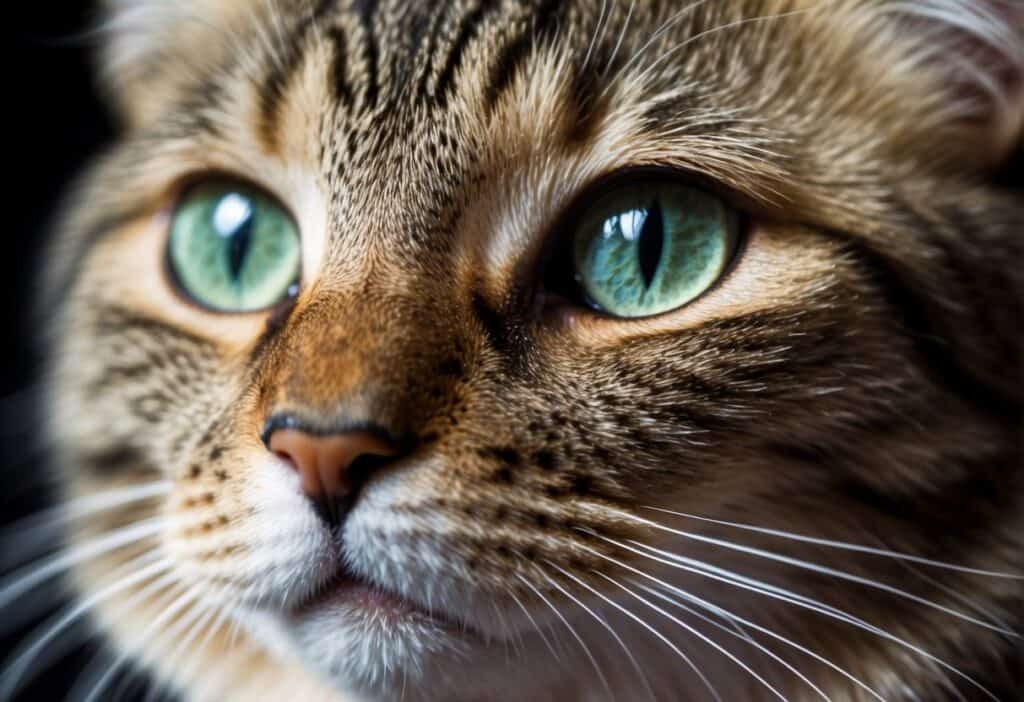How Risky Can Nasal Cryptococcosis in Cats Be? Understanding the Dangers

Nasal cryptococcosis in cats is a significant fungal infection primarily affecting the respiratory tract, particularly the nasal cavity. Caused by the fungi Cryptococcus neoformans or Cryptococcus gattii, the disease poses several risks to feline health. If your cat is diagnosed with this condition, it could experience difficulty breathing, changes in appetite, weight loss, and issues with balance and coordination due to the infection’s potential to affect the central nervous system.

The disease generally enters a cat’s body through inhalation of contaminated soil, bird droppings, or decaying wood, where these fungi thrive. After affecting the nasal passage, the infection can spread, leading to more severe systemic problems. Your vigilance is crucial in detecting early signs, such as chronic nasal discharge and respiratory distress, which can help in seeking timely veterinary intervention.
The prognosis for nasal cryptococcosis in cats varies, and while many respond well to antifungal treatments, there is a risk of relapse. To reduce the chance of infection, keeping your cat indoors away from high-risk areas such as pigeon roosts is often recommended. Regular check-ups with your veterinarian are vital to ensure your cat remains healthy, especially if it has a history of this condition or other immune-compromising diseases.
Overview of Cryptococcosis in Cats
Cryptococcosis is a significant fungal disease that can affect your cat, often presenting as a nasal infection. This illness is primarily caused by the encapsulated yeast fungi Cryptococcus neoformans and Cryptococcus gattii.
Symptoms and Affected Areas:
- Predominantly targets the respiratory tract, especially the nasal cavity
- Can spread to the central nervous system (CNS), eyes, and skin
- Symptoms may include difficulty breathing, weight loss, and reduced appetite
- When affecting the CNS, changes in behavior and neurological symptoms could arise
The disease takes two forms in tissues:
- Encapsulated yeast form
- Filamentous form (environmental)
Mode of Infection:
- Picked up from the environment
- Inhaled as basidiospores or desiccated yeasts
If you suspect your cat has cryptococcosis, a thorough veterinary examination is necessary. The treatment typically involves antifungal medications and may vary depending on the severity and location of the infection. Regular monitoring of liver and renal function might be advised during treatment given the potential side effects of certain antifungal drugs. Given that cryptococcosis can be serious, prompt veterinary care can be crucial to prevent the disease from progressing and to manage symptoms effectively.
Etiology and Transmission

Cryptococcosis in cats is primarily caused by two variants of the Cryptococcus fungus, and it is commonly transmitted through spores found in the environment.
Cryptococcus Species and Variants
Cryptococcus neoformans and Cryptococcus gattii are the two main species responsible for nasal cryptococcosis in cats. C. neoformans is found globally and is often associated with areas containing avian guanos, especially from pigeons. C. gattii, while less common, occurs in tropical and subtropical regions and has been linked to decaying vegetation.
- Cryptococcus neoformans: commonly found in bird droppings, especially from pigeons; prevalent globally.
- Cryptococcus gattii: associated with eucalyptus trees and decaying wood; prevalent in tropical and subtropical climates.
Routes of Transmission
Your cat can become infected with Cryptococcus by inhaling basidiospores, which are the infectious spores produced by these fungi. The spores are microscopic and can become airborne from environmental sources such as soil contaminated with pigeon droppings or decomposing matter like wood and leaves.
- Inhalation of basidiospores: the primary transmission route; occurs when your cat breathes in spores from the contaminated environment.
- Contact with contaminated areas: including soil, pigeon habitats, and areas with heavy decaying vegetation.
While Cryptococcus spores are common in many environments, the risk of infection is higher in locations with large amounts of bird droppings or decaying wood, putting pets that venture outdoors, wildlife, and farm animals like cattle, horses, and sheep at increased risk of exposure.
Clinical Signs of Nasal Cryptococcosis
Nasal cryptococcosis in cats can manifest a range of clinical signs that affect the nasal passages, the skin, and potentially the central nervous system. Recognizing these symptoms is crucial for timely diagnosis and treatment.
Nasal and Respiratory Symptoms
Your cat may display signs of nasal discomfort such as sneezing, chronic nasal discharge that could appear mucopurulent, serous, or hemorrhagic, and is often bilateral. You may also notice difficulties in breathing, if the infection causes significant obstruction within the nasal passages.
- Nasal discharge: thick, bloody, or green
- Sneezing: persistent and severe
Cutaneous Manifestations
Swelling or a polyp-like mass in the nostril and the presence of firm, subcutaneous swelling over the bridge of the nose could be indicative of nasal cryptococcosis. Additionally, the infection can invade nearby tissues, including the skin, causing visible lesions on the face and neck.
- Swelling: evident on the nose or under the skin of the face
- Lesions: skin abnormalities that may signal deeper tissue involvement
Systemic Involvement
Should the infection spread, systemic signs can become apparent. Cryptococcosis may affect the central nervous system (CNS), potentially leading to more severe conditions like cryptococcal meningitis. Affected cats might show neurological symptoms such as seizures or appear disoriented. Involvement of the eyes could result in blindness, and issues with ears can cause problems with balance.
- CNS symptoms: disorientation, seizures
- Eyes: possible loss of vision or changes in eye appearance
- Ears: balance issues or unusual head tilting
Diagnosis and Detection
In diagnosing nasal cryptococcosis, your veterinarian will conduct thorough physical examinations and specific diagnostic tests to detect the presence of the fungus Cryptococcus.
Physical Examination Findings
During a physical examination, specific signs your veterinarian will look for include nasal discharge, which can be mucoid or bloody, and swelling or deformity of the nasal bridge. The presence of firm, raised lesions or nodules in the nasal cavity may also be indicative of cryptococcosis. Your vet may observe respiratory signs such as sneezing or difficulty breathing, which suggest involvement of the respiratory tract.
Diagnostic Testing
Diagnostic testing for nasal cryptococcosis primarily involves:
- Antigen detection tests, such as the Latex Agglutination Test (LAT), which can be used on your cat’s blood, urine, or cerebrospinal fluid. LAT is preferred due to its high sensitivity for cryptococcal antigen titers.
- Examination of tissue samples from the nasal cavity may include cytology or histopathological analysis. Specialized staining techniques, such as immunohistochemistry, may be applied to detect the organism.
- PCR (Polymerase Chain Reaction) is another test that may be utilized for its accuracy in identifying the genetic material of the Cryptococcus species within a sample.
It is critical to note that while the antigen test is highly effective, false negatives can occur, especially in cases with localized infection. If initial blood tests return negative but clinical signs continue to indicate cryptococcosis, further testing of other bodily fluids or tissues may be warranted.
Treatment Options
When your cat is diagnosed with nasal cryptococcosis, effectively managing the condition is critical for their health. Treatment usually involves a combination of antifungal drugs and, in some cases, surgical interventions.
Pharmacological Treatments
Antifungal drugs are the cornerstone of treating nasal cryptococcosis in cats.
- Fluconazole: This is often the first-line medication due to its ability to penetrate the central nervous system and its lower toxicity to cats. You could expect to administer this drug to your cat over several months.
- Itraconazole: Another effective antifungal, itraconazole can be used, especially if fluconazole is not well tolerated or if you’re dealing with a fluconazole-resistant strain of Cryptococcus.
- Amphotericin B: In severe cases, amphotericin B might be recommended. Due to its potential side effects, it’s generally used when other treatments have failed or the infection is particularly aggressive.
- Flucytosine: Sometimes used in combination with amphotericin B, flucytosine can increase the efficacy of treatment. However, it can be costly and can also have side effects.
- Ketoconazole: This drug is less commonly used due to its side effects and the availability of safer alternatives, but it may still be prescribed in certain circumstances.
Dosage and duration of these medications depend on your cat’s specific condition and response to treatment. Continuous monitoring with follow-up appointments will be necessary to adjust dosages and to determine when to stop treatment to prevent recurrence.
Surgical Interventions
In cases where there are visible lesions or the infection has caused significant physical obstruction:
- Surgical Excision: Surgery might be required to remove any accessible lesions to aid in recovery and to reduce the fungal load, making pharmacological treatments more effective.
Prognosis and Management
When addressing nasal cryptococcosis in cats, the prognosis largely depends on the timeliness of diagnosis and the implementation of an appropriate, sustained treatment regimen. With early detection and consistent treatment, many cats experience a favourable recovery. However, it’s crucial to be aware of symptoms like anorexia and weight loss, which can signal the disease’s presence and severity.
Treatment Approach:
- Antifungal Medication: Your vet will prescribe antifungal drugs, typically for a period of several months.
- Follow-up Tests: Regular follow-up is necessary to monitor the effectiveness of treatment.
Management Strategies:
- Ensure your cat completes the entire course of medication, even if symptoms improve.
- Monitor your cat’s appetite and weight closely. Anorexia and weight loss need to be addressed promptly to prevent further complications.
- Maintain a stress-free environment for your cat to support recovery.
Remember, the recovery journey can vary from one cat to another. Strict adherence to the treatment and vet consultations will significantly influence the outcome. Keep a watchful eye on any behavioural or health changes, and don’t hesitate to seek veterinary advice if you have concerns about your cat’s progress.
Epidemiology and Geographical Distribution
Cryptococcosis, which includes nasal cryptococcosis, is a systemic fungal disease caused by the yeasts Cryptococcus neoformans and Cryptococcus gattii. Your understanding of its prevalence is crucial, especially when dealing with feline patients.
- Cryptococcus neoformans commonly affects cats and is found in bird droppings, particularly those of pigeons, which contribute to its widespread distribution.
- In contrast, Cryptococcus gattii, although less common, has been associated with eucalyptus trees and can also infect cats.
Here is how this disease spans across different regions:
| Continent | Prevalence |
|---|---|
| Australia | C. gattii is more prevalent, particularly in the warmer regions. |
| North America | Both C. neoformans and C. gattii are present, with cases of feline nasal cryptococcosis reported mostly in the Pacific Northwest and California. |
| Europe | C. neoformans is predominantly found, with urban areas displaying higher incidence rates due to pigeon populations. |
As a cat owner or veterinarian, you should be aware that environmental exposure differs based on geographical location, influencing the risk and type of cryptococcal infection your cat may encounter. In temperate zones, C. neoformans is typically implicated, while in tropical or subtropical areas, C. gattii is more prevalent, with Australia reporting a significant number of cases.
By understanding these patterns, you can better assess the risk and take appropriate measures to protect your feline companions from this potentially serious infection.
Prevention and Public Health Concerns
Your role in preventing nasal cryptococcosis in domestic animals, particularly cats, involves maintaining a clean environment and minimizing exposure to areas with a high concentration of fungal spores. It is essential to reduce risk factors for both wild and domestic animals as this infection can be disseminated through various organ systems.
Prevention Strategies:
- Limiting outdoor exposure can reduce interaction with the infectious agent, Cryptococcus spp., found in soil and bird droppings.
- Regularly cleaning areas where pets spend time discourages the growth of fungi.
- Ensuring that your cats have limited interaction with wild animals can lower the chance of disease transmission.
Serotypes and Pathogenicity:
- Understanding that different serotypes and genotypes of Cryptococcus possess varying levels of pathogenicity can help in assessing the risk to your pets.
- Serotype A is more commonly associated with the disease and is typically seen in cats.
Public Health Concerns: When considering public health, be aware of the zoonotic potential, albeit low, of cryptococcosis. Immune-compromised individuals are more susceptible to infection, making it a concern in households with such persons.
- Wear gloves when handling soil or materials possibly contaminated with the fungus to prevent zoonotic transmission.
- If a pet is diagnosed, follow your veterinarian’s advice on treating your animal to prevent further spread.
Remember that dissemination to the central nervous system is a severe complication of nasal cryptococcosis. Early detection and treatment are crucial in protecting the health of both your animals and human family members.
Impact on Human Health
Cryptococcosis in cats is primarily a concern for animal health, but it does carry a zoonotic potential, meaning it can be transmitted to humans. Your awareness of the risk factors is vital for prevention.
Zoonotic Potential
Cryptococcus species, including Cryptococcus neoformans and Cryptococcus gattii, are capable of causing infection in humans, particularly in immunocompromised individuals. Cats can carry these fungi, particularly in their nasal passages, and while transmission to humans is relatively rare, it’s important to be aware that the disease can cross species barriers.
Risk Factors for Transmission to Humans
The primary environmental risk factors for cryptococcal transmission are:
- Proximity to infected animals: Close contact with cats showing symptoms of nasal cryptococcosis increases your risk.
- Environmental exposure: Encountering environments where Cryptococcus species thrive, such as areas with bird (especially pigeon) droppings, can elevate your risk of exposure.
You should also consider your personal risk factors, which include:
- If you are immunocompromised due to conditions like HIV/AIDS, organ transplantation, or corticosteroid use, exercise heightened caution.
- Engaging in activities that disturb material contaminated with Cryptococcus, like cleanup or excavation sites, demands appropriate protective measures.







